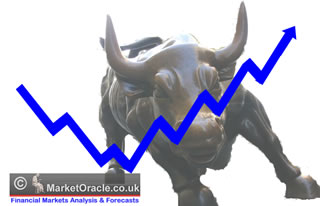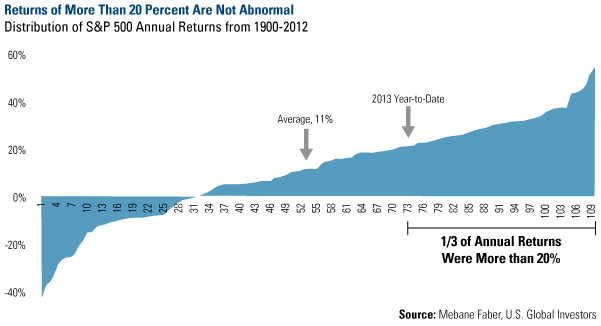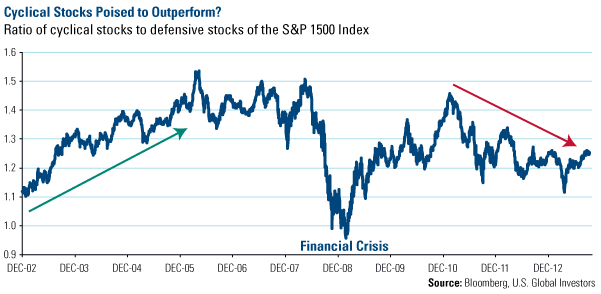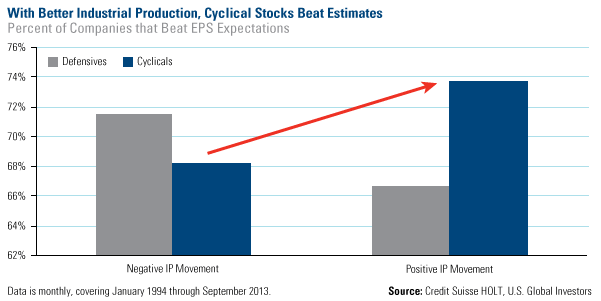Trying to Stop Stocks Bull Market Has Risks
Stock-Markets / Stocks Bull Market Oct 23, 2013 - 05:16 PM GMTBy: Frank_Holmes
 U.S. stocks have been on a tear. The S&P 500 Index has climbed a surprising 20 percent so far this year, as a global synchronized recovery takes shape and funds flow back to equities. As I often say, investors take risks when they try to stop a bull run, and plenty of data suggest you might regret taking that action this year.
U.S. stocks have been on a tear. The S&P 500 Index has climbed a surprising 20 percent so far this year, as a global synchronized recovery takes shape and funds flow back to equities. As I often say, investors take risks when they try to stop a bull run, and plenty of data suggest you might regret taking that action this year.
Consider the optimistic views from Joshua Brown, i.e. The Reformed Broker, as we have "all the rocket fuel we need for an explosion." There's no election, no war in Syria, and no taper talk. Banks are highly capitalized, stocks around the world are cheap and hedge funds' short positions are the highest since January, says Brown.
 If his post doesn't convince you, we have even more ammunition, especially regarding cyclical and growth stocks.
If his post doesn't convince you, we have even more ammunition, especially regarding cyclical and growth stocks.
1. Year-to-date returns of more than 20 percent are not abnormal
Did you know going back to 1900, the market's annual returns have been more than 20 percent about one-third of the time? Take a look at the distribution of S&P 500 annual returns charted by Mebane Faber Research, which shows the possibility of stocks going higher.
If you were able to invest in the market during the entire 112 years, you would have pocketed an average of 11 percent. But even though the 2013 market return has been more than the average, there were more than 30 years when stocks increased more. Of course, we can't guarantee future performance, but history has seen years when stocks increased 25, 30 or even 40 percent over the entire calendar year.

2. Improving economic growth prospects point to cyclical stocks to lead the way
Last spring, our director of research, John Derrick, CFA, recognized an inflection point occurring in U.S. stocks, with cyclical areas of the market beginning to gain strength while defensive companies suddenly started lagging. Large-cap, relatively stable companies such as Procter & Gamble, AT&T and Clorox dropped sharply at that time. If you watched the market closely, you sensed a mean reversion taking place as expectations seemed too lofty for defensives and too gloomy for cyclicals.
This was a vital signal to growth investors, and those who were paying attention to the quiet ignition of cyclical stocks were wise to take advantage of this change.
On the chart below, you can see the abrupt switch in leadership from defensive stocks to cyclical sectors. The line plots the ratio of cyclical areas to defensive areas of the S&P 1500 Index. When the line is rising, cyclical companies (consumer discretionary, energy, financials, industrials, materials and technology) outperform; when the line is falling, defensives (consumer staples, health care, telecommunications and utilities) outperform.
Over the past decade, you can see that cyclical stocks outperformed from 2002 through 2005. But since the end of 2010, the longer-term trend for cyclicals has been heading downward--until recently. Now, after a prolonged period of underperformance, cyclicals appear poised to outperform.

John continues to believe that with countries such as the U.S., Europe and China improving, cyclical and high-growth areas of the U.S. market will likely continue to take off. As investors have been reallocating out of bonds and cash into equities on expectations that interest rates may rise, chances are good that this money will find its way into cyclical areas of the market.
3. Rising industrial production is positive for cyclical stocks.
As a measure of output of the industrial sector, industrial production (IP) around the world has been building momentum. In August, the IP in the U.S. and the eurozone grew more than anticipated. In September, China's IP rose 10.2 percent, which is the second-highest growth rate this year, according to China Daily.
Historically when the economy has had positive industrial production momentum, a higher percentage of cyclical companies experienced better-than-expected earnings. And companies that beat earnings typically experience a boost in stock prices.

There appears to be plenty of gunpowder in the chamber for growth stocks. Like I said above, trying to stop a bull market has risks. With $32 billion pouring into equity funds in September and another $12.7 billion into stock funds in one week in October, many investors are jumping into the market. What action are you taking?
Want to receive more commentaries like this one? Sign up to receive email updates from Frank Holmes and the rest of the U.S. Global Investors team, follow us on Twitter or like us on Facebook.
By Frank Holmes
CEO and Chief Investment Officer
U.S. Global Investors
U.S. Global Investors, Inc. is an investment management firm specializing in gold, natural resources, emerging markets and global infrastructure opportunities around the world. The company, headquartered in San Antonio, Texas, manages 13 no-load mutual funds in the U.S. Global Investors fund family, as well as funds for international clients.
All opinions expressed and data provided are subject to change without notice. Some of these opinions may not be appropriate to every investor.Standard deviation is a measure of the dispersion of a set of data from its mean. The more spread apart the data, the higher the deviation. Standard deviation is also known as historical volatility. All opinions expressed and data provided are subject to change without notice. Some of these opinions may not be appropriate to every investor. The S&P 500 Stock Index is a widely recognized capitalization-weighted index of 500 common stock prices in U.S. companies. The NYSE Arca Gold BUGS (Basket of Unhedged Gold Stocks) Index (HUI) is a modified equal dollar weighted index of companies involved in gold mining. The HUI Index was designed to provide significant exposure to near term movements in gold prices by including companies that do not hedge their gold production beyond 1.5 years. The MSCI Emerging Markets Index is a free float-adjusted market capitalization index that is designed to measure equity market performance in the global emerging markets. The U.S. Trade Weighted Dollar Index provides a general indication of the international value of the U.S. dollar.
Frank Holmes Archive |
© 2005-2022 http://www.MarketOracle.co.uk - The Market Oracle is a FREE Daily Financial Markets Analysis & Forecasting online publication.



